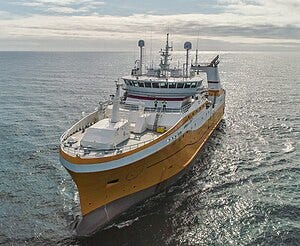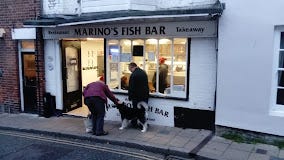Food has gone bonkers. First, there are too many people (many of them working people) who can’t get hold of enough of it. There are people whose only affordable food is making them involuntarily obese and expensively sick. There are people who are making a small fortune photographing themselves and the food they eat and filming what they cook. There is innovative food which could threaten further the sources we should be protecting. Then there is food which is pushing the envelope in a way that is frankly bizarre.
In this category - because you are already well aware of the issues surrounding the first three, comes a London-based project turning chicken feathers into food.
Kera Protein began as a student project in 2019 on how to tackle waste management. Sorawut Kittbanthom, studying at London’s Central Saint Martin’s, was not looking at “creating something new, just optimizing what we already have.”
3 million tonnes of poultry feathers go to waste annually in the EU alone, mostly dumped into landfills. (Can you guess where we’re going with this?) Such waste material, Sorawut Kittbanthom knew, is full of keratin, the protein that creates skin, nails, and hair - as you may know from your shampoo’s packaging. Kera Protein mixes it all up with acid and an enzyme to break it down then cooks it, filters it, cools it, and turns it into collagen and a meat-mimicking substance that contains other positive stuff. (I’m struggling a little here…) A Thai supper club the company has collaborated with recently hosted a 6-course feast to demonstrate the versatility of feather product which included classic Thai dishes like laab and a raw ‘beef’ salad.
This is one of the rare occasions when I’m thinking landfill might be the more palatable option.
Meanwhile in the innovative food category, one restaurant in the USA is serving fish and marine products that come from so far deep in the ocean no-one has ever seen them on a plate before. This in a nation where 85 percent of restaurant food is unused and thrown out while an estimated 33.8 million Americans live in food-insecure households.
Peter Hemsley, chef of Aphotic, a Michelin-starred, seafood-only restaurant in San Francisco, is cooking fish that come from parts of the ocean over 1000 metres/3300 feet in depth where light cannot penetrate, thus the restaurant’s Greek name meaning ‘without light’. His Michelin star is a ‘Green Star’, a new designation recognising restaurants upholding eco-friendly culinary practices.
To keep up with market demand, 85 percent of seafood consumed in the United States comes from international, not coastal, waters. Aphotic is using only local suppliers. The Michelin guide writes that along with approving the restaurant for practising traditional culinary techniques, their Green Star is a result of Hemsley “sourcing exceptional seafood from small sustainable purveyors”.
What distinguishes much of the fish Hemsley cooks is that it comes from what he calls “the dark ocean”. When it shows up in the nets of large commercial fishing trawlers, it is unfamiliar fish hard to sell to a generally conservative market so is usually thrown back, although no longer fit to survive. In Hemsley’s case, this is the fish he is actively seeking to buy. “Finding things that are special and unique in the world is part of the challenge in designing an experience for a discerning clientele”.
While the backing Hemsley gives to small purveyors along with his curiosity about how best to treat exotic specimens is laudable, the fishing methods considered most protective of fish stocks are rod-and-reel and pole-and-line. These catch those fish, sold in-store as ‘line-caught’, which don’t swim down so deep a line couldn’t possibly reach them. For molluscs, the most sustainable fishing method is to dive down to select each one, thus the ‘hand-dived’ designation for scallops, for instance. Trawlers dragging their nets for scallops scour up the seabed, destroying all living things including the sand eels vital to the survival of puffins.
I’m nit-picking. There’s not much of a case to hold against a restaurant providing a living to fishing boats reaching into the dark depths to supply a chef with unusual stock when the price of a Tasting Menu at Aphotic is the sum of one month’s food budget for a good many households. But for true sustainability, rather than fish more deeply for startling seafood, shouldn’t we be fishing less altogether, and allowing popular stocks to replenish themselves in a natural time span?
Fish-and-chips is Britain’s national dish (a better choice than the toast-and-marmalade which was the only thing that came to mind when I was asked in the US to produce the UK’s national dish for International Day - until I remembered sandwiches).
The Brits can’t hold their heads up high when it comes to sources for the supply of cod and haddock, the fish most commonly served in chippies. They come predominantly from the Icelandic, Norwegian and Barents Seas where around one-twelfth of the total is caught by the Kirkella, a British freezer-trawler so big it contains a cinema and a gym.
This, though, is a plate of fish and chips with cod caught by a local family’s boat in the English Channel and served at Marino’s in Rye. If you’re visiting London, Rye is worth a day trip. It’s the photogenically quaint town where Henry James lived. There’s a popular photo-op to be had outside The Mermaid, the pub whose exterior wall reads ‘Rebuilt in 1420’ after the town was burnt to the ground by French Raiders on June 22nd, 1377.
If you can’t get to Rye, here’s a recipe for the best, crispiest, lightest batter for fish.
For 4 pieces of fish
400g/14oz plain flour
550ml/18½ fl oz very cold beer from the refrigerator or chilled soda water
3 teaspoons baking powder
½ tsp salt
vegetable oil for frying, enough to deeply fill a pan or wok
Dump the flour into a bowl and set it in the freezer for at least 15 minutes. This is the magic trick: when chilly batter meets hot oil it crisps up instantly!
While the oil is heating up in your pan, stir the baking powder and salt into the chilled flour, then, not too forcefully so you don’t make the batter tough, whisk in the cold beer or soda water to make a paste the consistency of thick whipping cream.
Once the oil is hot enough so that when you drip a drop of water into it, it immediately sizzles away, dip the fish into the batter, lower it into the hot oil and fry, all pieces together if they don’t crowd the pan, or two at a time, for 4 to 6 minutes depending on the size of the fillets, until crisp and gold. With a slotted spoon, scoop each piece out and lay briefly on kitchen paper to drain then tuck in, with chips, malt vinegar and salt.








Live & learn: I shall chill the flour next time for sure. And thank you for the rest of this. The way we source our seafood is abominable. It's why I try to eat mostly farmed fish. Most consumers, even conscientious ones, have absolutely no idea. Thank you, Julie!